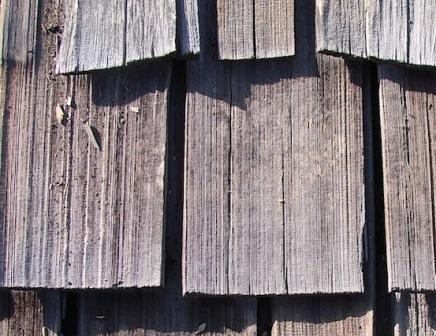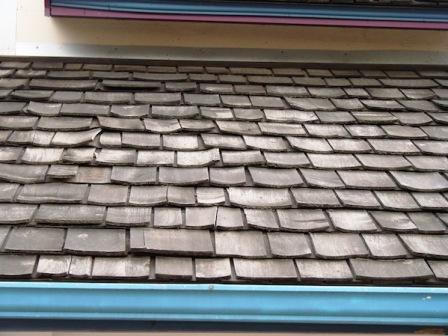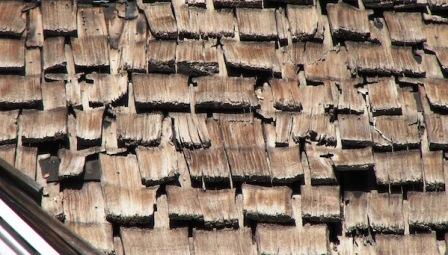Mastering Roof Inspections: Wood Shakes and Shingles, Part 7
by Kenton Shepard and Nick Gromicko, CMI®
The purpose of the series “Mastering Roof Inspections” is to teach home inspectors, as well as insurance and roofing professionals, how to recognize proper and improper conditions while inspecting steep-slope, residential roofs. This series covers roof framing, roofing materials, the attic, and the conditions that affect the roofing materials and components, including wind and hail.
Wood roofs should be maintained on a regular basis. Damaged or missing shakes or shingles should be replaced, and loose ones should be re-fastened. The roof and gutters should be cleaned, and tree branches should be trimmed back so that they don’t overhang the roof. Overhanging branches will cause leaves to accumulate on the roof and in gutters.
In areas subject to ice dam formation, nylon stockings filled with snow-melt chemicals can be used to melt through the dam to allow roof drainage. As fasteners loosen over time, cap shingles for ridges and hips will often begin to separate and allow moisture intrusion. They may lose wind resistance. Look for problems in valleys, at roof penetrations, and along the lower roof edges.
Squirrels and raccoons may chew or tear wood roofing, especially at areas that are decayed. Shingles with this kind of damage should be replaced.
The life expectancy of a roof varies, depending on a variety of factors, including the following:
- climate zone and local environmental factors , such as salt air, heat, humidity, precipitation, and hail;
- the quality of the shake or shingle;
- the quality of the installation;
- the quality of the maintenance;
- the amount of foot traffic; and
- any overhanging tree branches.
In addition, the CSSB recommends that pressure-treated shakes and shingles be used in the following states:
- Alabama,
- Delaware,
- Florida,
- Georgia,
- Hawaii,
- Kentucky,
- Maryland,
- Mississippi,
- North Carolina,
- South Carolina,
- Virginia and
- West Virginia.
Pressure-treated shakes and shingles should also be used in the following counties of Texas:
- Angelina,
- Austin,
- Brazos,
- Chambers,
- Fort Bend,
- Galveston,
- Grimes,
- Hardin,
- Harris,
- Jasper,
- Jefferson,
- Liberty,
- Montgomery,
- Newton,
- Orange,
- Polk,
- Sabine,
- San Augustine,
- San Jacinto,
- Trinity,
- Tyler,
- Walker,
- Waller and
- Washington.
Wood Roof Repair Methods
Repairing damaged areas of wood roofs generally means replacing shakes or shingles.
Removing and replacing a shake or shingle is easy and takes less than five minutes.
Using a hammer, the shake is driven up far enough to pull the fasteners loose. The shake is then removed.
A new shake of the right size is inserted into place, and fasteners are installed beneath the butt of the overlying shake. If fasteners are angled up toward the peak, they’ll help pull the shingle up the roof as they’re driven, helping to hide the fasteners.
End of Useful Life
Once you understand the fundamentals of wood roofs, you’ll develop an increasingly better sense of where a roof stands in its lifespan at the time of your inspection. Wood roofs may last anywhere from 20 to 60 years. Talking to contractors in your area will help you develop a realistic idea of how long wood roofs can be expected to last locally.
An important factor regarding the speed at which a wood roof ages has to do with a combination of the factors listed above. Roofs located in harsher climate zones and those whose home site conditions degrade wood roofs will require more diligent maintenance. The quality of the material and installation are important, too.
More important than estimating the remaining lifespan is being able to recognize when a roof is near or at the end of its useful life.
Here are some of the clues that a roof is nearing the end of its useful life. They apply mainly to field shakes and shingles over a significant portion of the roof.

There are many loose, split or missing shakes or shingles.

Splits leave inadequate sidelaps.

The underlayment or roof deck is exposed.

Fasteners are exposed. It’s not uncommon to see fasteners exposed, and this alone does not indicate failure, but it’s one more clue when combined with other conditions of failure.

There are many areas where shakes or shingles are thin or eroded through.
Widespread distortion (cupping or curling) is seen across a significant portion of the roof.

Cupping or curling is typically not a reason to describe a roof as at or near the end of its useful life. The exception is if it’s widespread and allowing moisture intrusion. The roof in the photo above indicates a cause for concern but the roof would not be recommended for repair unless there were signs of moisture intrusion.

The photo above shows a wood shingle roof that has been installed with interlayment that has reduced its ability to dry, resulting in excessive distortion, splitting and loss of shingles.

A large percentage of decay is typically found in butts.
**************************************************
Learn how to master a roof inspection from beginning to end by reading the entire InterNACHI series: Mastering Roof Inspections.
Take InterNACHI’s free, online Roofing Inspection Course
Mastering Roof Inspections
Roofing Underlayment Types
Inspecting Underlayment on Roofs
Fall-Arrest Systems
Roofing (consumer-targeted)
More inspection articles like this

